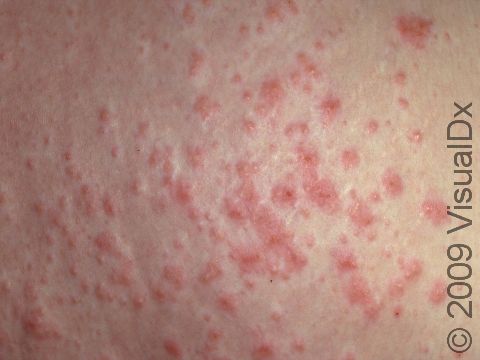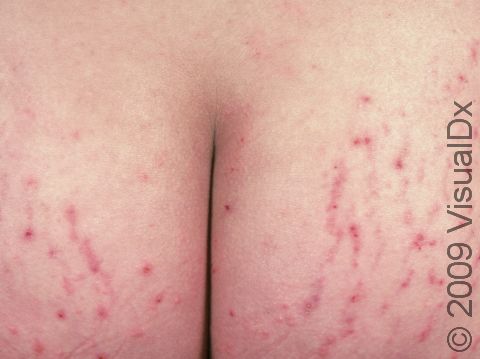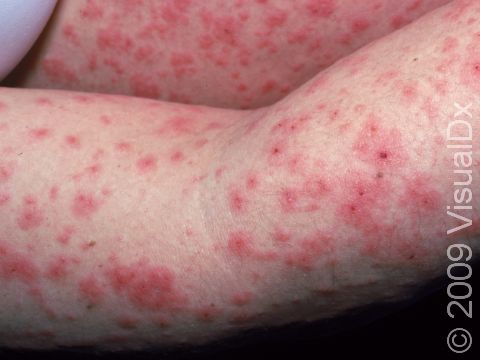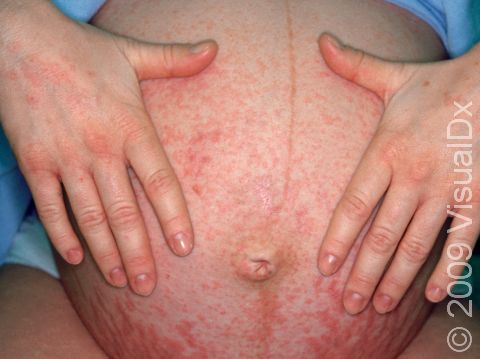PUPPP (Pruritic Urticarial Papules Plaques of Pregnancy)
Pruritic urticarial papules and plaques of pregnancy (PUPPP) is the most common skin condition of pregnancy. In PUPPP, tiny red bumps appear on the abdomen, particularly in areas already affected by stretch marks; the bumps are intensely itchy. Over time, the many small bumps merge together into one extraordinarily itchy bump around the belly button. It is not uncommon for this bump, which resembles an allergic hive, to be so itchy that the affected woman has trouble sleeping at night. Typically, within a few days after delivery of the baby, the bumps and itchiness go away entirely. PUPPP is not associated with any serious health conditions in women or their babies.
Who's At Risk?
PUPPP is very common in pregnant women, occurring in about 1 in every 200–300 pregnant women. It usually appears in the third trimester of the pregnancy. PUPPP is most common in a woman’s first pregnancy and in women expecting multiple babies. PUPPP is much less common in pregnancies occurring after the first baby.
Signs & Symptoms
PUPPP involves itchy, raised red areas mixed with small 1–2 mm bumps that are surrounded by a thin, pale area known as a halo. Occasionally, these bumps can be filled with fluid. They more commonly appear within a stretch mark. The lesions start on the belly and progress to the legs, back, buttocks, arms, and breasts. The itching can be extremely intense at night. PUPPP usually goes away about a week postpartum but can disappear anywhere from a week before delivery to up to 6 weeks postpartum. In rare cases, PUPPP may worsen postpartum.
Self-Care Guidelines
It is important to try to not scratch the skin and to get a lot of rest. Thick moisturizers should be applied liberally at least twice a day. An antihistamine such as Benadryl® (diphenhydramine, Pregnancy Class B*) can be used to help with the itching but may make you drowsy. Claritin® and Zyrtec® (loratadine and cetirizine, Pregnancy Class B*) are considered to be non-sedating and may help during the day.
* Pregnancy Class B: Animal studies have not demonstrated a fetal risk, but there have been no controlled studies in pregnant women. If animal studies showed a negative effect, this was not seen in controlled studies in women in the first trimester, and there is no evidence of risk in later trimesters.
Treatments
Your doctor may give you a prescription for a topical corticosteroid. In rare cases, you may need oral corticosteroids.
Visit Urgency
There has been no correlation of PUPPP with any health problems with either mothers or their babies. Seek medical care if the itching is not well controlled with self-care measures or there are signs of infection due to scratching.
Trusted Links
References
Broza Z, Kasperska-Zajac A, Oles E, Rogala B. Pruritic urticarial papules and plaques of pregnancy. J Midwifery Womens Health. 2007 Jan-Feb;52(1):44-8. Review.
PMID: 17207750
Last modified on August 16th, 2022 at 2:44 pm

Not sure what to look for?
Try our new Rash and Skin Condition Finder



